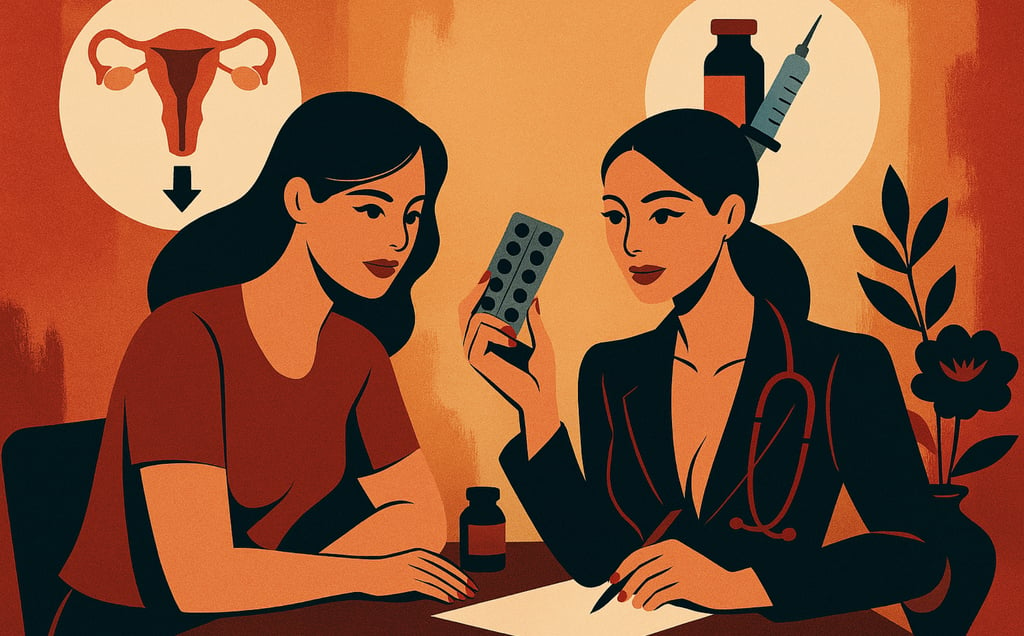IVF Downregulation Explained
What IVF downregulation means, how long it lasts, and what to expect during this hormone-suppressing phase of a long protocol IVF cycle, including side effects.
THE IVF PROCESS STEP BY STEP


Downregulation is one of those IVF terms that sounds a bit intimidating at first — like something clinical, complicated, and vaguely sinister. But in reality, it’s just one phase of certain IVF protocols, especially the long protocol, designed to give your medical team more control over your hormone levels and cycle timing. If your clinic has recommended this step, it likely means they’re using a long protocol IVF approach — often used for women with regular cycles, under 35, or when a more predictable ovarian response is desired.
In this post, we’ll walk you through what downregulation actually is, why it’s used, how it’s done, and what you might experience during this part of your fertility treatment.
What Is Downregulation in IVF?
Downregulation is the first phase of a long protocol IVF cycle, where the aim is to temporarily "switch off" your body’s natural hormone production. Think of it as putting your ovaries into a gentle, reversible sleep.
This is done to:
Prevent ovulation from happening too early
Stop your body from interfering with the stimulation meds that come later
Give your doctor more precise control over your cycle
Once your body’s natural cycle is suppressed, your team can start stimulation medication (like Gonal-F or Menopur) to grow multiple follicles more predictably.
How Does Downregulation Work?
The Medications
In the UK, the most commonly prescribed medications for downregulation include:
Nafarelin (Synarel) – a nasal spray taken twice daily
Buserelin – an injection
Decapeptyl – a depot injection (slow release)
These medications are GnRH agonists — they initially cause a flare of reproductive hormones, and then suppress the signal from the brain to the ovaries.
Timing
Downregulation typically begins in the mid-luteal phase of your cycle (around day 21) and lasts for 2 to 4 weeks. Some clinics require a “downregulation scan” to confirm that your ovaries are quiet before proceeding to the next phase.
Why Is Downregulation Used?
Not all IVF cycles use downregulation — it’s specific to the long protocol.
Benefits:
Reduces the risk of ovulating too early
Helps synchronize the growth of multiple follicles
Provides more predictability and control
Can reduce the risk of cycle cancellation due to unexpected hormone spikes
When it’s recommended:
You have regular cycles
You’re under 35
You’re doing IVF on the NHS, where the long protocol is still widely used
Your clinic believes it gives you the best chance of success
What Does Downregulation Feel Like?
This part can vary quite a bit from person to person. Some people breeze through it. Others find it a bit rough — emotionally, physically, or both.
Common side effects:
Hot flushes
Mood swings or low mood
Headaches
Fatigue
Sleep disruption
Vaginal dryness or spotting
These effects are temporary and should settle once stimulation starts. But if you feel off — especially emotionally — it’s not just in your head. You’re being put into a mini, medically induced menopause. Your body is doing something big.
Many people compare this phase to early menopause, which makes sense — you’re suppressing oestrogen production, after all.
Tips for Coping During Downregulation
Hydration and light exercise can help with fatigue and headaches
Keep a cooling mist spray or fan on hand for hot flushes
Track your symptoms with an app or journal — it can help you feel more in control
Talk to someone — a partner, friend, counsellor — especially if your mood dips
Remind yourself: this is temporary, and it’s getting you one step closer to your goal
What Comes Next?
Once your scan confirms downregulation is complete, you’ll move into the stimulation phase, where medication is used to grow multiple follicles. Many people feel much better once they’ve switched to this stage — energy picks up, mood improves, and there’s a renewed sense of momentum.
My Downregulation Experience
I’ve been through downregulation twice already — and I’m due to start again in just a week to prepare for my frozen embryo transfer (FET). Both times, I used Norethisterone, and to be honest, I actually felt really good while I was on it. My mood was stable, my energy was fine, and everything felt quite manageable.
But the tricky part always came right after stopping.
Each time, the sudden hormone drop hit me hard. It was like my system crashed overnight. I’d go from calm and steady to extremely irritable, like something inside me had snapped. Once, it even led to a huge fight with my partner. I knew it was the hormones, but in the moment, it felt overwhelming and uncontrollable.
I also got a migraine both times — not just a regular headache, but a stabbing pain behind one eye that lasted for days. It’s become a weird marker for me now — I know the migraine means the Norethisterone has left my system.
So while the downregulation phase itself felt surprisingly okay, I’ve learned to brace myself for the drop after stopping. It helps to be aware of it, talk about it with my partner, and remind myself that this is all part of the process — temporary, but powerful.
Downregulation can feel like a strange limbo — not quite starting, not quite stopping — and it’s not always the easiest phase of IVF. But it plays a critical role in helping your clinic guide your body toward a successful egg collection. If it feels hard, know that you’re not alone — and that it does pass.
To read more:
© 2025. All rights reserved.
